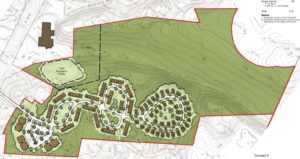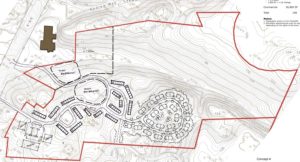TRURO — Consultants from Tighe & Bond presented four scenarios for developing a 28.5-acre tract at the Nov. 9 meeting of the Walsh Property Community Planning Committee.
The town purchased the nearly 70 acres for $5.1 million in 2019. Designated as “Area A,” the 28.5 acres now being discussed are in an upland area along the southwest edge of the property. It is one of two areas that Tighe & Bond had identified as developable in January, based on topography, groundwater quality, and open space needs.
The firm’s most recent analysis views 33.5 acres of Walsh land as developable and recommends preserving the remaining 35.5 acres as open space.
Consultants Gordon Leedy, Carole Ridley, and Sharon Rooney created four design concepts for Area A and emphasized that aspects could be mixed and matched.
The first scenario has 57 single-family houses, each sited on a quarter-acre lot and including a one-car garage. There are two points of access to Route 6: Walsh Way and one unnamed but already paved road that would be shared with Truro Central School.

The second option has 108 residential units: 28 two-story townhouses and 80 single-family units configured as duplexes. Walsh Way would be the primary access to the site, with Short Lots Lane being a possible second or emergency access, pending legal considerations, Leedy said.

The third scenario has 210 residential units: 78 apartments in three three-story buildings plus 94 townhouses and 38 single-family houses. Each townhouse and single-family house would include a one-car garage. As in option two, Walsh Way would be the primary access and Short Lots Lane could be a second or emergency access.

The fourth scenario includes 26,800 square feet of commercial space and 123 residential units. Three commercial buildings would be at the west edge of the property, nearest to Route 6, while 81 townhouses would be built near the center of Area A and 42 single-family houses farther east.

All four scenarios set aside seven acres that could be used for additions to the school, Rooney said, and for recreation facilities in the meantime.
Leedy said the town’s water resources consultant, Scott Horsley, led him to conclude the Walsh property could accommodate 200 to 225 housing units “without running afoul of the nitrate loading standards that are in the aquifer recharge areas.”
Some planning committee members raised objections.
“I’m just curious why, in three of the plans, there would basically be a quarter of the town living on that property,” said Christine Markowski. “It would change the profile of Truro. And I find that very upsetting.”
Committee member Steve Wynne agreed. “When I first saw these four plans,” he said, “it was the density of the homes packed into the small space that really took me by surprise.”
Committee member Russell Braun expressed concern over costs. “How can you talk about mix of units etc. without talking about money?” he asked.
Rooney said that Tighe & Bond will be reaching out to potential developers “once we have a little bit more clarity on the direction the committee wants to take.”
“I’m trying to reconcile my head around the chicken and the egg,” said committee member Eileen Breslin. She expressed concern over the site’s density, access to Route 6, and water supply. “I fully support the need for housing,” she said, and brought up adding a health clinic or swimming pool. “We have to be thoughtful about the character of Truro,” Breslin concluded. “My reaction to a three-story apartment building was, ‘Oh my goodness, that’s not the essence of Truro.’ ”
The three-story garden apartments “are pretty standard in New England, in terms of the development style,” Leedy said. It would be difficult to prioritize affordable housing, he said, without increasing density. “I’m not making a value judgment about that,” he said. “It’s just one of the trade-offs that you may need to make if that’s the goal of the project.”
Committee member Betty Gallo is also a member of the town’s housing authority. “We came up with 260 units needed by 2035,” she said. “That’s what we’re going to need if we plan to keep moving and keep growing.”
Alternate member Jeffrey Fischer was not deterred by density. “It will be a little bit different for Truro,” he said, “but we need the affordable housing.”
Member Jane Lea echoed Fischer’s sentiment. “I’m quite confused about the ‘character of Truro,’ ” she said. “In the 30-plus years I’ve lived here, the character of Truro has changed quite a bit. We’ll always have open land, but we need to preserve a diverse community in order to survive. If we’re talking about the character of Truro, right now it’s wealthy white retirees.”
“I’m not scared of three-story buildings,” said committee alternate Raphael Richter. “We’re talking about our people, the people that are going to make this town run.” He reminded the group that “we have our principles that we decided upon last time.” Community housing was part of that list, he said, and “town character” was not.
Co-chair Paul Wisotzky concurred: “If we want to address the housing crisis that we have in this town, we have to have density. There are some mega-mansions out there on the bluff of Route 6 that are far bigger than three-story apartment buildings.”
Co-chair Fred Gaechter agreed with the need for higher density but “not density for density’s sake.” The town’s housing needs assessment is in the process of being approved, and it “needs to drive what types of density” get prioritized in Area A, he said.
“If it’s a fait accompli that it’s going to be high density without consensus, I’m upset about that,” said Markowski.
At the beginning of the Nov. 9 meeting, Gaechter reminded committee members that the group operates primarily by consensus. “The chairs declare consensus when it’s apparent that all members can be in acceptance of what’s on the table even when they may not be in favor of every component of it,” he said. If consensus cannot be reached, the committee resorts to a vote.
“Are we trying to help Provincetown with their workers?” Markowski asked. “Provincetown has overdeveloped on that little spit of sand and I don’t know why Truro has to pay for that.”
“You can never separate Truro’s economy from Provincetown,” said member Morgan Clark. “The committee needs to consider that all of our economies and all of our needs are tied in together.”
Following this discussion, Ridley said that she counted seven members who prefer higher density proposals, three who favor less dense options, and two who didn’t express a preference.
The committee — which has 13 members and two alternates — has two vacancies with the recent resignation of Craig Milan and the death of Susan Howe. “We’ll try to fill them as quickly as we can,” said Gaechter.
Following a brief discussion, Gaechter declared “consensus on Area A as our primary development area, pending discussion of any other water issues or anything else.”
Wisotzky reminded the committee of its charge as an advisory body. It will bring recommendations to Truro’s annual town meeting in April. “We need to be responsive to the community,” Wisotzky said. “It’s not really what we want — it’s ‘What are we hearing?’ ”
